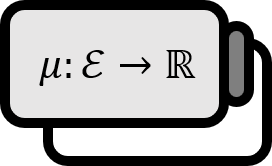Signed Measures
Definition1
Let $(X, \mathcal{E})$ be a measurable space. A function $\nu : \mathcal{E} \to \overline{\mathbb{R}}$ which takes extended real values and satisfies the conditions below is called a signed measure.
- $\nu ( \varnothing ) = 0$
- At most one of $\pm \infty$ can have a function value of $\nu$. In other words, if $-\infty \in \nu (\mathcal{E})$ then $+\infty \notin \nu (\mathcal{E})$, and if $+\infty \in \nu (\mathcal{E})$ then $-\infty \notin \nu (\mathcal{E})$.
- Let $\left\{E_{j}\right\}$ be a sequence of mutually exclusive sets in $\mathcal{E}$. Then it satisfies $\nu \left( \bigcup \nolimits_{j=1}^\infty E_{j} \right) =\sum \limits_{j=1}^\infty \nu (E_{j})$. When $\nu (\cup _{1}^\infty E_{j})$ is finite, the sum on the right converges absolutely.
Explanation
Simply put, it is a generalization of measure that allows for negative values. Therefore, if it is a measure, it is also a signed measure. When mentioning measure and signed measure together, to emphasize, a measure is sometimes called a positive measure. A specific example of a signed measure is the Riemann integral.
Meanwhile, since a measure always has to have a non-negative function value, it can be thought of as taking the absolute value of any function’s Riemann integral. Also, every signed measure can be represented as the difference between two measures.
$$ \nu = \mu_{1} -\mu_2 $$
Properties
Let $\nu$ be a signed measure defined on a measurable space $(X,\mathcal{E})$.
Continuity from below:
Let $\left\{ E_{j} \right\}_{1}^\infty \subset \mathcal{E}$ be a monotone increasing sequence, which means $E_{1} \subset E_2 \subset \cdots$. Then the following holds: $$ \mu\left( \bigcup \nolimits _{1}^\infty E_{j} \right)= \lim \limits_{j\rightarrow \infty} \mu (E_{j}) $$
Continuity from above:
Let $\left\{ E_{j} \right\}_{1}^\infty \subset \mathcal{E}$ be a monotone decreasing sequence, which means $E_{1} \supset E_2 \supset \cdots$. And let $\mu (E_{1})<\infty$. Then the following holds: $$ \mu\left(\bigcap \nolimits _{1}^\infty E_{j} \right)= \lim \limits_{j\rightarrow \infty} \mu (E_{j}) $$
Fundamentally, the proofs are the same as in measure1. The proof in the context of measures required countable additivity, and since signed measures also have countable additivity, the proof method is the same. Therefore, it is omitted.
